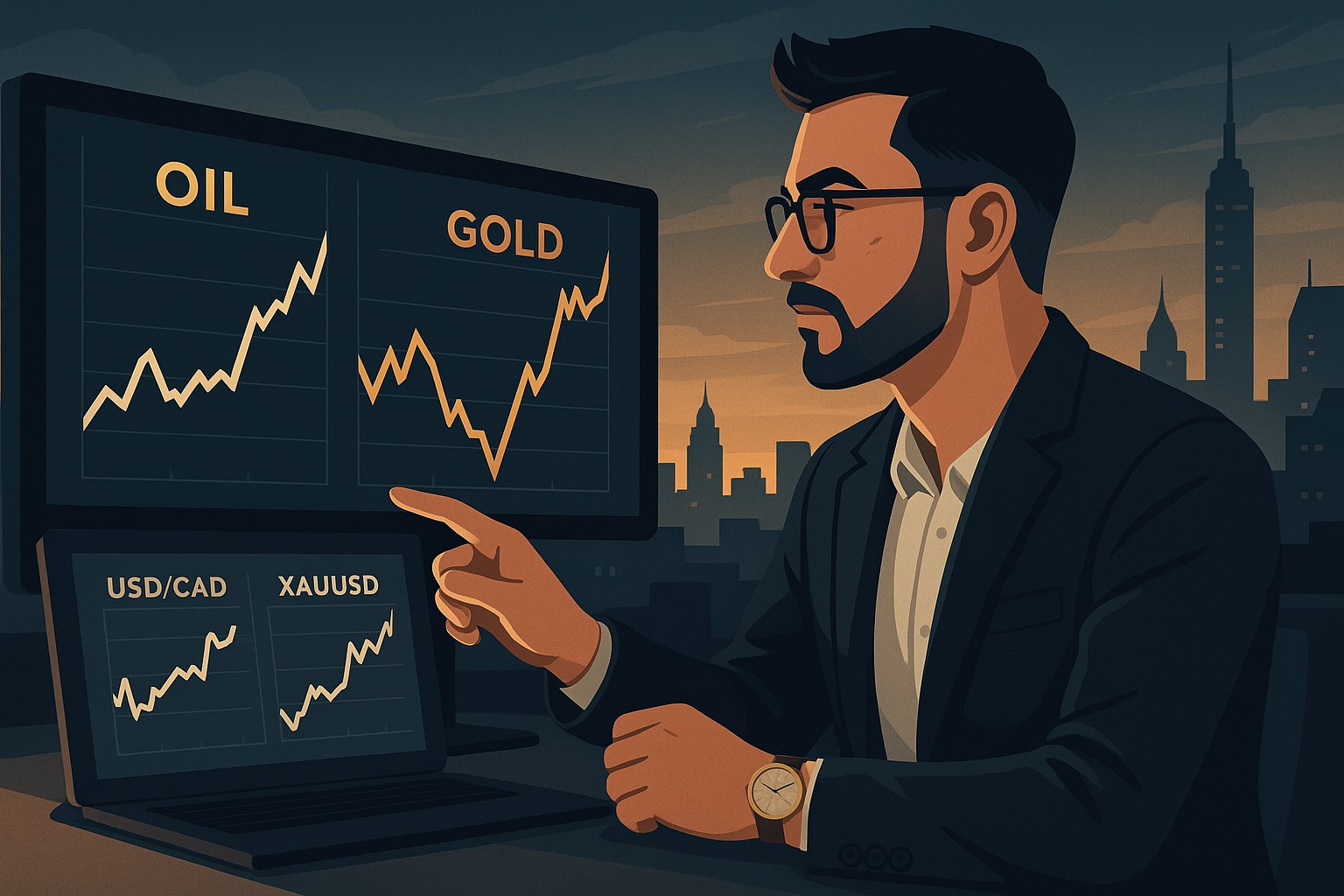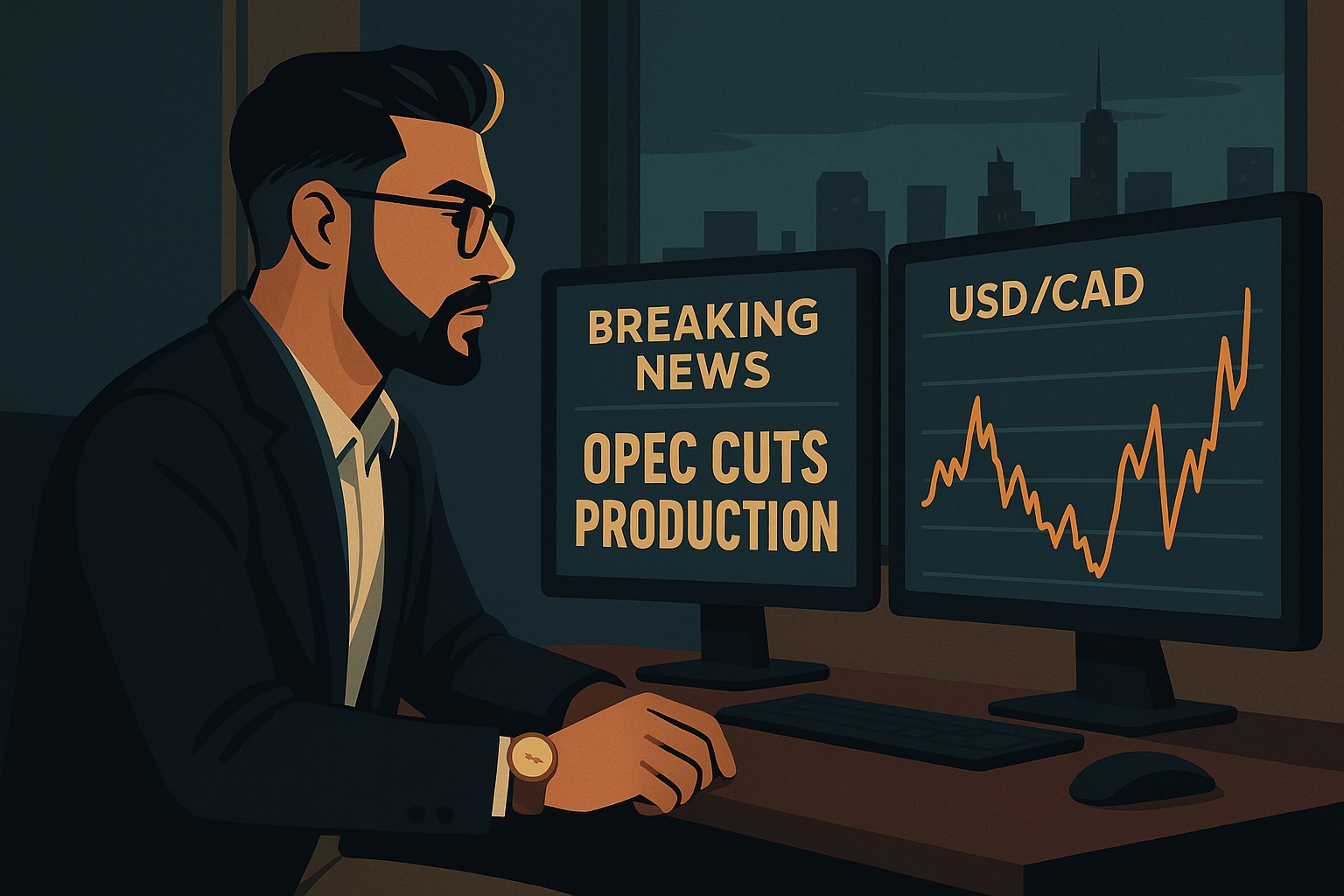Commodities & Global Trade: Oil, Gold, and Forex Explained
2025-10-02 11:09:39
When you think of trading forex, the first thing that usually comes to mind is currencies: USD, EUR, JPY, GBP. But here’s the truth - currencies don’t move in isolation. Behind every currency’s rise and fall are deeper forces, and one of the most powerful is commodities.
Oil, gold, and other raw materials are more than things we buy and sell; they are the fuel tanks of the global economy. When oil gets expensive, when gold suddenly climbs, or when supply chains choke, forex traders feel the impact immediately. If you’ve ever wondered why CAD surges when oil rallies, or why gold pops when fear spreads, this is why. If you’re just getting started with gold, anchor on a structured playbook like this Complete Step-by-Step Guide to Day Trading Gold (XAU/USD) so every move in the metal connects to a tradeable plan.
Let’s break this down together - because if you’re serious about becoming a consistent trader, you can’t ignore how commodities and global trade ripple through the markets.
Oil & Gold: The market’s compass

Whenever I sit at my trading desk, I check two things before diving into charts: oil and gold. Why? Because they reveal what’s happening under the hood.
- Oil is the lifeblood of the world economy. When oil prices rise, oil-exporting countries like Canada and Norway usually benefit. Their currencies strengthen because higher oil revenue improves fiscal and trade balances. But for importers like Japan or India, expensive oil squeezes growth and weakens their currencies. To see this dynamic in a single pair, study the USD/CAD: The Oil-Backed Pair.
- Gold is the thermometer of fear. When uncertainty grows - wars, inflation, policy shocks - investors flock to gold. It’s the safety bunker. If gold is central to your watchlist, go deeper with Why Gold Remains the Ultimate Security in a Shifting World.
The OPEC factor & supply chain shocks

Two invisible hands often nudge these tanks up or down:
- OPEC decisions. When OPEC+ cuts production, supply tightens and prices spike; when they open the taps, prices soften. These are classic catalysts for oil-linked FX pairs. (For official statements and output decisions, see the OPEC website.)
- Supply chain disruptions. Pandemic-era port backlogs, Red Sea shipping risks, or refinery outages can amplify price swings. Higher transport and input costs feed straight into inflation - which then shapes central-bank behavior. If you’re building a news-day playbook, pair your commodity view with this CPI/NFP approach: Why Smart Money Concepts Work in News-Driven Markets.
Real-life analogy: Commodities as the fuel tanks

Think of the global economy as a fleet of vehicles. Oil and gold are the fuel tanks.
- When oil is scarce (production cuts), it’s like fuel prices soaring. Exporters sell fuel and thrive; importers burn cash and slow down.
- When fuel quality is doubted (policy uncertainty, war, inflation), drivers tap the reserve tank - gold - until confidence returns.
No driver ignores the fuel gauge. In trading, many do - and then wonder why the “engine” sputters right before a big move.
How this hits forex - directly
Let’s make it practical:
- CAD (Canada) often strengthens when oil rises. That’s why oil rallies can coincide with USD/CAD drops. Revisit the correlation nuances inside the USD/CAD: The Oil-Backed Pair.
- AUD (Australia) is a commodity-levered currency (gold, iron ore). When global demand is healthy and metals bid, AUD usually rides higher. Build context with AUD/USD: The Commodity Currency.
- JPY (Japan) imports most of its energy. Rising oil can pressure the trade balance and weigh on JPY, especially when risk sentiment is shaky. If you trade sentiment around commodities, level up with How to Identify Risk-On and Risk-Off Market Sentiment.
Beyond individual pairs, commodities steer mood. Oil spikes can stoke inflation fears and dampen risk appetite; sharp gold bids often mirror a flight to safety. Tie that macro “mood read” back into your SMC execution plan using the Power of Multi-Timeframe Analysis so you’re aligning narrative with structure.
Final thoughts

Here’s the real takeaway: commodities aren’t background noise; they’re front and center. Oil and gold act like your engine’s fuel and your reserve tank. Ignore them, and you’re driving without a gauge. Watch them, and you’ll notice the market’s heartbeat - when to accelerate, when to coast, when to pull over.
When I started, I’d stare at EUR/USD or USD/JPY and feel blindsided. Then I learned to ask, “What did oil and gold just do?” Suddenly the puzzle pieces snapped together. Moves made sense. I didn’t force trades into a vacuum - I integrated the world outside the chart.
FAQs
Why does oil impact USD/CAD so strongly?
Canada exports oil; higher crude improves CAD’s backdrop, often pushing USD/CAD lower. It’s not a one-to-one lever - but it’s a reliable context.
Is gold always a safe haven?
Mostly - but not always. In liquidity crunches, funds can sell anything (even gold) to raise cash. Over a wider window, gold tends to attract flows when uncertainty rises.
Which other commodities matter for FX?
Iron ore (AUD), natural gas (NOK/USD seasonality), copper (CLP, global growth proxy). Think “who sells it, who buys it, and who sets the price.”
How do supply chain shocks hit currencies?
They raise costs for importers, feed inflation, and force policy responses. The chain is: logistics stress → higher inputs → CPI pressure → rate expectations → FX repricing. For a CPI day checklist, keep this guide handy: How to Trade CPI Like Smart Money.
Start Practicing with Confidence - Risk-Free!
- Trade forex, indices, gold, and more
- Access ACY, MT4, MT5, & Copy Trading Platforms
- Practice with zero risk
It’s time to go from theory to execution - risk-free.
Create an Account. Start Your Free Demo!
Check Out My Contents:
Strategies That You Can Use
Looking for step-by-step approaches you can plug straight into the charts? Start here:
- How To Trade & Scalp Indices at the Open Using Smart Money Concepts (SMC)
- How to Trade Breakouts Effectively in Day Trading with Smart Money Concepts
- Complete Step-by-Step Guide to Day Trading Gold (XAU/USD) with Smart Money Concepts (SMC)
- The Power of Multi-Timeframe Analysis in Smart Money Concepts (SMC)
- Forex Trading Strategy for Beginners
- Mastering Candlestick Pattern Analysis with the SMC Strategy for Day Trading
- How to Use Fibonacci to Set Targets & Stops (Complete Guide)
- RSI Divergence Trading Strategy for Gold: How to Identify and Trade Trend Reversals
- Stochastics Trading Secrets: How to Time Entries in Trending Markets using Stochastics
- Gold Trading Stochastics Strategy: How to Trade Gold with 2R - 3R Targets
- RSI Hidden Divergence Explained: How to Spot Trend Continuations Like a Pro
- Moving Averages Trading Strategy Playbook
- Mastering Fibonacci Trading Psychology - Trusting the Levels, Managing the Mind
- Mastering Price Action at Key Levels - How to Spot, Trade, and Win at the Most Crucial Zones
- Mastering Retests: How to Enter with Confirmation After a Breakout
Indicators / Tools for Trading
Sharpen your edge with proven tools and frameworks:
- The Ultimate Guide to Risk Management in Trading - A Complete Compilation for 2025
- Moving Averages Trading Strategy Playbook
- How to Think Like a Price Action Trader
- Mastering Fibonacci Trading Psychology - Trusting the Levels, Managing the Mind
How To Trade News
News moves markets fast. Learn how to keep pace with SMC-based playbooks:
- Why Smart Money Concepts Work in News-Driven Markets - CPI, NFP, and More
- How to Trade NFP Using Smart Money Concepts (SMC)-A Proven Strategy for Forex Traders
- How to Trade CPI Like Smart Money - A Step-by-Step Guide Using SMC
Learn How to Trade US Indices
From NASDAQ opens to DAX trends, here’s how to approach indices like a pro:
- How to Start Trading Indices and Get into the Stock Market with Low Capital (2025 Guide)
- Best Indices to Trade for Day Traders | NASDAQ, S&P 500, DAX + Best Times to Trade Them
- How To Trade & Scalp Indices at the Open Using Smart Money Concepts (SMC)
- NAS100 - How to Trade the Nasdaq Like a Pro (Smart Money Edition)
How to Start Trading Gold
Gold remains one of the most traded assets - - here’s how to approach it with confidence:
- How to Swing Trade Gold (XAU/USD) Using Smart Money Concepts: A Simple Guide for Traders
- Complete Step-by-Step Guide to Day Trading Gold (XAU/USD) with Smart Money Concepts (SMC)
- The Ultimate Guide to Backtesting and Trading Gold (XAU/USD) Using Smart Money Concepts (SMC)
- Why Gold Remains the Ultimate Security in a Shifting World
- How to Exit & Take Profits in Trading Gold Like a Pro: Using RSI, Range Breakdowns, and MAs as Your Confluence
How to Trade Japanese Candlesticks
Candlesticks are the building blocks of price action. Master the most powerful ones:
- Mastering the Top Japanese Candlesticks: The Top 5 Candlesticks To Trade + Top SMC Candlestick Pattern
- How to Trade Candlestick Patterns with High Probability: A Complete Guide for Beginners
- The Top Japanese Candlestick Guide: What is an Engulfing Pattern and How to Trade It?
- Piercing Pattern Candlestick Explained: How to Trade It - Step-By-Step Guide
- Morning & Evening Star Candlestick Patterns - How to Trade Market Reversals with Confidence
How to Start Day Trading
Ready to go intraday? Here’s how to build consistency step by step:
- 5 Steps to Start Day Trading: A Strategic Guide for Beginners
- 8 Steps How to Start Forex Day Trading in 2025: A Beginner’s Step-by-Step Guide
- 3 Steps to Build a Trading Routine for Consistency and Discipline - Day Trading Edition
- The Ultimate Guide to Understanding Market Trends and Price Action
- Trading with Momentum: The Best Trading Session to Trade Forex, Gold and Indices
Learn how to navigate yourself in times of turmoil
Markets swing between calm and chaos. Learn to read risk-on vs risk-off like a pro:
- How to Identify Risk-On and Risk-Off Market Sentiment: A Complete Trader’s Guide
- How to Trade Risk-On and Risk-Off Sentiment - With Technical Confirmation
- The Ultimate Guide to Understanding Market Trends and Price Action
Want to learn how to trade like the Smart Money?
Step inside the playbook of institutional traders with SMC concepts explained:
- Why Smart Money Concepts Work: The Truth Behind Liquidity and Price Action
- Mastering the Market with Smart Money Concepts: 5 Strategic Approaches
- Understanding Liquidity Sweep: How Smart Money Trades Liquidity Zones in Forex, Gold, US Indices
- The SMC Playbook Series Part 1: What Moves the Markets? Key Drivers Behind Forex, Gold & Stock Indices
- The SMC Playbook Series Part 2: How to Spot Liquidity Pools in Trading-Internal vs External Liquidity Explained
- Fair Value Gaps Explained: How Smart Money Leaves Footprints in the Market
- Accumulation, Manipulation, Distribution: The Hidden Cycle That Runs Every Market
- Institutional Order Flow - Reading the Market Through the Eyes of the Big Players
- London Session Trading Secrets: How Smart Money Sets the High & Low of the Day
- Mastering the New York Session - Smart Money Concepts Guide
Master the World’s Most Popular Forex Pairs
Forex pairs aren’t created equal - - some are stable, some are volatile, others tied to commodities or sessions.
- The Top 5 All-Time Best Forex Pairs to Trade
- Top Forex Pairs Beyond the Big Five
- EUR/USD: The King of Forex
- USD/JPY: The Fast Mover
- GBP/USD: The Volatile Cable
- AUD/USD: The Commodity Currency
- USD/CAD: The Oil-Backed Pair
- GBP/JPY: How to Trade The Beast
- Asian & London Session Secrets
- Mastering the New York Session
Stop Hunting 101
If you’ve ever been stopped out right before the market reverses - - this is why:
- Stop Hunting 101: How Swing Highs and Lows Become Liquidity Traps
- Outsmarting Stop Hunts: The Psychology Behind the Trap
- How to Lessen Risk From Stop Hunts in Trading
- How Stop Hunts Trigger Revenge Trading - Breaking the Pain Cycle
- How to Accept Stop Hunts Without Losing Discipline - Shifting From Frustration to Focus
Trading Psychology
Mindset is the deciding factor between growth and blowups. Explore these essentials:
- The Mental Game of Execution - Debunking the Common Trading Psychology
- Managing Trading Losses: Why You Can Be Wrong and Still Win Big in Trading
- The Hidden Threat in Trading: How Performance Anxiety Sabotages Your Edge
- Why 90% of Retail Traders Fail Even with Profitable Trading Strategies
- Top 10 Habits Profitable Traders Follow Daily to Stay Consistent
- Top 10 Trading Rules of the Most Successful Traders
- Top 10 Ways to Prevent Emotional Trading and Stay Disciplined in the Markets
- Why Most Traders Fail - Trading Psychology & The Hidden Mental Game
- Emotional Awareness in Trading - Naming Your Triggers
- Discipline vs. Impulse in Trading - Step-by Step Guide How to Build Control
- Trading Journal & Reflection - The Trader’s Mirror
- Overcoming FOMO & Revenge Trading in Forex - Why Patience Pays
- Risk of Ruin in Trading - Respect the Math of Survival
- Identity-Based Trading: Become Your Trading System for Consistency
- Trading Psychology: Aligning Emotions with Your System
- Mastering Fear in Trading: Turn Doubt into a Protective Signal
- Mastering Greed in Trading: Turn Ambition into Controlled Growth
- Mastering Boredom in Trading: From Restless Clicking to Patient Precision
- Mastering Doubt in Trading: Building Confidence Through Backtesting and Pattern Recognition
- Mastering Impatience in Trading: Turn Patience Into Profit
- Mastering Frustration in Trading: Turning Losses Into Lessons
- Mastering Hope in Trading: Replacing Denial With Discipline
- When to Quit on Trading - Read This!
- The Math of Compounding in Trading
- Why Daily Wins Matter More Than Big Wins
- Scaling in Trading: When & How to Increase Lot Sizes
- Why Patience in Trading Fuels the Compounding Growth
- Step-by-Step Guide on How to Manage Losses for Compounding Growth
- The Daily Habits of Profitable Traders: Building Your Compounding Routine
- Trading Edge: Definition, Misconceptions & Casino Analogy
- Finding Your Edge: From Chaos to Clarity
- Proving Your Edge: Backtesting Without Bias
- Forward Testing in Trading: How to Prove Your Edge Live
- Measuring Your Edge: Metrics That Matter
- Refining Your Edge: Iteration Without Overfitting
- The EDGE Framework: Knowing When and How to Evolve as a Trader
- Scaling Your Edge: From Small Account to Consistency
Market Drivers
- Central Banks and Interest Rates: How They Move Your Trades
- Inflation & Economic Data: CPI Trading Strategy and PPI Indicator Guide
- Geopolitical Risks & Safe Havens in Trading (Gold, USD, JPY, CHF)
Risk Management
The real edge in trading isn’t strategy - it’s how you protect your capital:
- Mastering Risk Management: Stop Loss, Take Profit, and Position Sizing
- Why Risk Management Is the Only Edge That Lasts
- How Much Should You Risk per Trade? (1%, 2%, or Less?)
- The Ultimate Risk Management Plan for Prop Firm Traders - Updated 2025
- Mastering Position Sizing: Automate or Calculate Your Risk Like a Pro
- Martingale Strategy in Trading: Compounding Power or Double-Edged Sword?
- How to Add to Winners Using Cost Averaging and Martingale Principle with Price Confirmation
Suggested Learning Path
If you’re not sure where to start, follow this roadmap:
- Start with Trading Psychology → Build the mindset first.
- Move into Risk Management → Learn how to protect capital.
- Explore Strategies & Tools → Candlesticks, Fibonacci, MAs, Indicators.
- Apply to Assets → Gold, Indices, Forex sessions.
- Advance to Smart Money Concepts (SMC) → Learn how institutions trade.
- Specialize → Stop Hunts, News Trading, Turmoil Navigation.
This way, you’ll grow from foundation → application → mastery, instead of jumping around randomly.
Follow me for more daily market insights!
Jasper Osita - LinkedIn - FXStreet - YouTube
This content may have been written by a third party. ACY makes no representation or warranty and assumes no liability as to the accuracy or completeness of the information provided, nor any loss arising from any investment based on a recommendation, forecast or other information supplies by any third-party. This content is information only, and does not constitute financial, investment or other advice on which you can rely.















